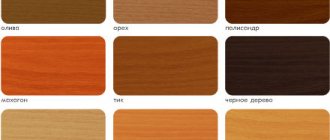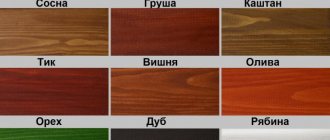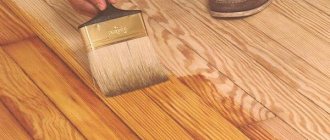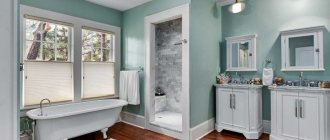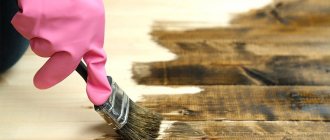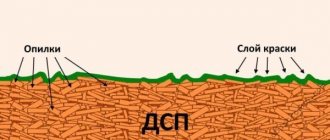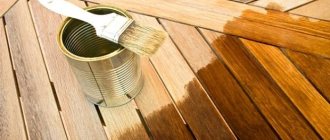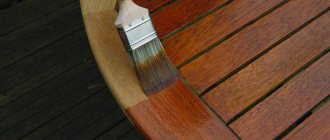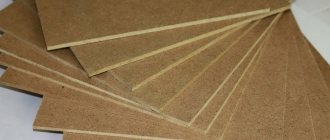Wood is one of the most popular materials for construction, which does not lose its popularity in our time. The main qualities for which we love wood are environmental friendliness, comfort, visual appeal and good thermal insulation.
Let's talk in more detail about what wood paints exist for interior and exterior work, and what to choose.
Acrylic
Acrylic-based wood paints are very profitable compositions from a commercial point of view. Among their positive qualities it is worth noting:
- Cheapness. The cheapest of all types of polymers with equivalent performance qualities.
- Practicality. They tolerate the effects of sunlight, as well as temperature changes. Shelf life – 3 years.
- Fast drying.
- Mechanical resistance. Acrylic paint creates a dense, elastic coating that is resistant to various influences.
- Water resistance. Wood under acrylic does not rot or collapse.
- Resistant to temperature changes.
- Possibility of tinting in any desired color.
Painted surfaces do not fade in the sun. The chemical composition of acrylic polymers is constantly being improved. Manufacturers are working to reduce the cost of such paints, but at the same time their quality remains at a high level.
The qualitative characteristics of acrylic water-dispersion paints are determined by the level of whiteness and hiding power. The highest level of whiteness is achieved by the purity of titanium dioxide used as a pigment. The ability to hide a surface treated with such enamel with a small number of layers is called hiding power. This parameter determines the cost of paint and directly depends on the pigment it contains, indicating its thickness and density. The contents of the jar should not be too liquid (a 10-liter can weighs 15 kg).
Important! When purchasing a product, make sure that the enamel is intended specifically for working with wood.
Primary and secondary staining
The primary coloring technique is used to give natural hair a single color throughout the entire mass or when completely changing the color.
- The mass of hair is divided by two partings (cross) - a straight parting and a parting from ear to ear, resulting in four parts.
- The dye is applied to the hair in each part with a brush, starting from the back of the head from top to bottom along horizontal or diagonal partings, 1.5-2 cm away from the roots of the hair.
- There is natural heat at the roots of the hair, which can enhance the dyeing process and make the color brighter - the coloring will be uneven.
- Next, you need to apply the dye to the hair roots according to the same principle as to the length, and note the exposure time.
Secondary painting is a repetition of the existing painting system.
- You must first dye your regrown hair and refresh the color along the length of your hair.
- The entire mass of hair is divided with a cross and the dye is applied first to the roots along the cross, and then to the roots according to the previous distribution system.
- Half the time before the end of dyeing (from the last strand dyed at the roots), refresh the color (tinting) or dye along the length of the hair. To do this, a new, fresh coloring mixture is diluted.
- You cannot comb the dye from the roots to length, because... You can injure and tear your hair.
For all types of staining, it is important to follow the system (primary and secondary staining), because this is the basis of this type of service
In accordance with the general rules, when performing coloring, it is necessary to take into account the thickness of the hair, because... After coloring, thick hair will be lighter than the color desired by the client, and thin hair will be darker.
The hair on the marginal growth line is dyed last, because... they are thinner and more porous and can “pick up” more color than others, and may also leave an outline of paint on the skin (especially intense colors).
The higher the concentration of the oxidizing agent, the more oxygen it contains, which disperses the pigment more intensely and reduces the working time of the dye. The strength of the dye decreases - the coloring function changes.
According to the basic rules, tools and devices used for hair coloring should not contain metal parts, so that no reaction occurs and the coloring turns out to be of high quality.
The master must wear a protective uniform (apron) and seals, the client must wear a disposable peignoir and collar.
Alkyd
Unlike acrylic enamels, alkyd enamels consist of varnishes of the same name, which are a solution of thick resin with the addition of rosin, glycerin and vegetable oils. Additional components that can improve any properties can be included in the paint, then everything is mixed with a solvent.
Alkyd enamel dries in 2–3 days, does not lose color, and is durable. Such compositions are also suitable for street work. In addition, they have a number of advantages:
- water resistance;
- durability;
- low price;
- protection of wooden surfaces from rotting;
- resistance to mechanical stress.
Due to their properties, alkyd enamels are ideal for painting floors.
Advice! The variety of such paints in stores is huge, so don’t rush to buy the first one you come across, study everything thoroughly on the spot.
Principles of coloring
You can paint a metal surface without practical skills. It is enough to prepare the required materials, tools, coat the working surfaces with a primer, and apply paint.
Tools and materials
To carry out painting work you need to prepare:
- set of brushes, roller;
- paint container;
- stationery knife, masking tape;
- thick polyethylene film;
- primer;
- metal brush, sandpaper.
Sandpaper (Photo: Instagram / abraziv.by)
Preparation
Stages of preparing metal surfaces before painting:
- Rough metal processing. This removes serious contaminants and scale.
- Surface grinding. It is necessary to sand the metal with fine-grained sandpaper.
After stripping the metal, you need to cover the surrounding surfaces with film to avoid staining.
Puttying
If the surfaces to be painted are uneven and have many depressions, they need to be puttied. To do this, you need to buy a special mixture at a hardware store and apply it according to the instructions indicated on the container.
Padding
Surface priming is necessary to increase adhesion and increase the durability of the decorative coating
It is important to choose the appropriate composition so that the decorative layer maintains its integrity for a long time
Kinds
Types of primers:
- Inhibitory. If rust begins to form on the metal, the primer will stop the process of destruction of the material.
- Protective. Manufactured on the basis of phosphoric acid. After application, a strong, durable film is formed.
- Phosphating. Suitable for working with non-ferrous metals.
- Insulating. Manufactured on an alkyd or epoxy base. Form a durable film.
Primer for metal (Photo: Instagram / birgroupcompany)
Application principles
The principle of applying primer is simple:
- Remove any dirt and dust from the surface.
- Dilute the primer with water.
- Apply the composition using a roller. If you don't have a roller, you can use a wide brush.
Applying paint
Paint can be applied only after the primer has dried. Most coloring compounds are applied in one layer. For painting, you can use a spray gun connected to a compressor, a brush or a roller.
Safety precautions
Safety regulations:
- You should work in protective clothing, gloves, and a respirator.
- There should be no heating devices in the painting area.
- Do not use paint near open flame sources.
Girl in a respirator (Photo: Instagram / tkani_cochonnet)
To paint unprepared surfaces, you need to use anti-corrosion coatings. Instructions can be read on the packaging. It is better to use powder paint, but this requires a special camera and appropriate equipment.
Water-dispersed
Water acts as a diluent for such paints, so they are considered environmentally friendly and non-flammable. The binding polymers here can be petroleum or resin. The term “dispersive” means a mechanical suspension of solid elements in a liquid. Water-dispersion paints are produced in the form of a liquid paste. Immediately before starting work, they are diluted with water to the required consistency.
When the enamel is already applied to the surface, the water begins to evaporate, the coating hardens and acquires waterproof and fire-retardant qualities.
This material is popular among consumers because it has a number of advantages over other paints:
- environmental safety (dries within a couple of hours, evaporating only water);
- no odor;
- fire resistance;
- ease of operation;
- vapor permeability;
- high adhesion;
- service life up to 15 years;
- resistance to mechanical damage;
- relative cheapness.
The most important property of such enamel is water resistance, which significantly expands the range of its applications.
Important! Water-based paints must be stored at room temperature.
Technology
The technological process takes place in stages and includes the following stages:
- Preparing tools.
- Surface treatment.
- Painting.
- Additional processing, if necessary.
The wood processing stage plays a significant role. If this procedure is performed correctly, no problems will arise in future operation.
Polyurethane
The main properties of such paints are determined by the nature of the binding component on the basis of which they are produced. Polyurethane compounds have excellent viscosity, good adhesion to any surface and high protective properties (prevent the appearance of cracks in wood).
Polyurethane paints are available in a wide range of colors. Among their positive qualities it is worth noting:
- resistance to sudden changes in temperature and pressure;
- scratch resistance;
- high moisture resistance;
- non-toxic;
- fire safety;
- chemical resistance.
Advice! Having purchased 100% polyurethane paint, dilute it with a commercial solvent before work.
Functions of protective compounds
A good wood preservative should have the following features:
extending the service life of the material and the house as a whole;- preventing the appearance of deformation and cracks;
- maintaining the original color of wood;
- the ability to paint wood in any color;
- brings variety to design;
- protection from the negative effects of moisture, temperature changes and pests;
- prevents the proliferation of fungus, mold and other microorganisms that can destroy the structure of the tree.
Go to the Leroy Merlin catalog =>>
For external wall treatment, wood paints based on acrylic, oils, rubber, and alkyds are used. Each of these finishing materials has its own advantages and disadvantages, so let’s try to dwell on all the nuances and decide on the further choice.
Important!
Before applying decorative paint to wood, coat the material with antiseptic protective compounds.
Paint for different rooms
Before painting wooden surfaces in different rooms, you need to first think about a healthy microclimate. Follow these tips to choose the right paint:
- To preserve the texture or add the desired color to interior wooden doors, floors, panels and baseboards, use environmentally friendly water-based paints.
- If the house is entirely built of timber, and there is no desire to cover the walls with other material, paint the walls with acrylic paint. It will visually hide unevenness, and high vapor permeability will ensure dryness and comfort in living spaces. The same composition can be used to paint imitation timber.
- Paint children's rooms with easily washable acrylic compounds. They should not contain harmful impurities so as not to harm the child’s health. The Eco Label guarantees that this product is environmentally friendly.
- Decorate the bathroom and kitchen with latex or acrylic enamels, the structure of which contains antifungal agents. For the kitchen, use special paints from which grease stains can be easily washed off.
- To paint the walls in the corridor and hallway, choose special acrylic-latex paints that are resistant to abrasion and mechanical damage.
- Utility rooms in private homes also require maintenance. Here use inexpensive vinyl and acrylic enamels. In special areas for washing and drying clothes, use the same paints as in the bathroom/kitchen.
Important! Before painting begins, the wood must be treated with an antiseptic. This will help avoid damage by insects that live in large numbers in untreated wood.
Application technique
Of course, painting wooden walls must be done correctly so that the coating will please its owners for a long time. To do this, you need to resort to step-by-step instructions:
- First, the area of staining is measured. Calculate the required amount of material. Cover floors and furniture with film or newspapers.
- Remove dust from the surface to be painted. To do this, use a brush, roller or damp cloth. Heavy stains are washed with degreaser and detergents. When repainting, remove previous layers of paint and clean the surface with sandpaper.
- Cover scratches, cracks and dents with putty. Level with a spatula.
- The wood is treated with protective materials, a layer of primer is applied for better adhesion and to reduce the consumption of paint and varnish material. Putty and primer are selected that are compatible with the selected material. In the case of acrylic paint, these are textured acrylic compositions, preferably matching the brand.
- Rosettes, borders and decorative elements are secured. Choose the most convenient tool: roller, brush or spray gun. To paint small surfaces (plinths, window sills, frames, decorative elements), it is better to use a brush. It is more convenient to paint walls, floors and ceilings with a roller.
- The brush is held at a slight angle when working. Remove excess paint from the brush by lightly tapping it, rather than wiping it on the walls.
- Paint in wide stripes with further shading. Apply cross strokes for a smoother surface. Adjust the pressure on the brush. With weak pressure, the strokes will turn out thick and will go with gaps. And strong pressure will lead to the formation of unattractive smudges.
- The size of the roller is selected depending on the size of the area being treated. The roller must be completely dipped into the solution. Paint in a direction clearly away from you, applying neat intersecting strokes. They begin work by stepping back about a meter from the corner (this hard-to-reach area is then painted with a brush).
- It is better to apply acrylic in two layers to obtain a smooth and even surface. The desired color can be easily obtained using colors, pigments, and mixing different tones. The next layer must be applied after the first has completely dried. Drying time should be indicated in the paint instructions.
It is worth remembering that repeated layers are applied perpendicular to the previous ones. First, poorly painted areas are treated, then a roller or brush is applied along the joints, carefully smoothing the solution.
Acrylic material for wood can be called convenient to work with. It provides protection for wood surfaces from insects, moisture, and rot. Compared to other paints and varnishes, this option is more environmentally friendly and does not have a repulsive odor. That's why it is so often used for interior decoration in an apartment or house .
Review of manufacturers
Wood paint for interior work is produced by many domestic and foreign manufacturers. All of it is of fairly high quality, but you need to choose from the best, well-proven in the construction market:
- Finnish. This is one of the best concerns recognized throughout the world. The long work of specialists was crowned with excellent results. The compositions of this company are endowed with excellent qualities, high color fastness and wear resistance.
- Zobel is a high-quality German manufacturer of paints for interior woodwork. The products of this company are characterized by good protective properties against ultraviolet radiation and sudden temperature changes, and a wide range of colors.
- The enamel used as a finishing decorative coating is “Drevoplastic”. Its complex composition includes alkyds, providing easy application, as well as maximum protection from negative factors. When painted, it lies on the surface, creating the effect of liquid plastic and, at the same time, allowing the wood to breathe.
- The following companies have earned the trust of consumers for working with wood: “Ace”, “Sashco”, “Seiena Group”, “Kerakoll”, “BENNET”.
Each of the above paints is suitable for any surface: walls, ceiling, floor. However, don't go overboard with bright colors. Their excessive use (especially if the shades are completely incompatible) will have a bad effect on the perception of the room. However, you can fantasize, diluting bright tones with light ones as you like, and ultimately achieve the desired result.
Advice! For dark rooms, such as a corridor, lighter shades are suitable.
Paints are still very relevant in decoration. Many of them are made from environmentally friendly ingredients, are odorless, dry quickly, have a huge range of colors and are very convenient to use.
Types of varnishes for wood
- Polyurethane, dries quickly, very durable, has a specific smell;
- Water-based, intended for external and internal work, environmentally friendly, requires surface impregnation with soil, can dry up to 24 hours;
- Acrylic, with good decorative characteristics, but quite expensive;
- Nitrovarnish, used in furniture processing, has low light resistance.
Varnish can be either an independent coating or additional protection after applying paint to a wood base.
Important Features
Wood is a warm building material. Wooden houses look expensive and prestigious. There is always a pleasant atmosphere and microclimate inside. It has been scientifically proven that breathing air in rooms made of wood is beneficial.
Wood breathes, and therefore there must be constant air exchange inside houses. The material is able to absorb moisture and also release it during hot periods. This contributes to a pleasant microclimate.
The minimum service life is 50 years. But in practice, the house can last much longer. Largely due to compliance with operating rules, as well as finishing and protection. One of the key roles is played by painting the facade.
In general, house paint performs several functions. It is decorative as well as protective.
Having correctly determined what paint to paint the outside of the tree with, it will protect you from:
- precipitation;
- temperature fluctuations;
- insects;
- fungus and mold;
- ultraviolet;
- solar activity, etc.
The paint emphasizes and preserves the wood texture. This is also the most financially affordable finishing method. The correct selection of paints and varnishes allows you to forget about façade repairs for at least 3-4 years. Some paints last for 5-7 years, while others last only 1-2 years.
The assortment shows that paint for a wooden house is represented by different types and manufacturers. But not every paintwork material is suitable for the tasks under consideration.
When choosing a composition, you need to pay attention to:
- type of building material (logs, timber, block house, imitation timber, etc.);
- climatic zone of the house location;
- affordable budget;
- who will paint, etc.
If you make a mistake when choosing, you will have to redo everything. And this is a big investment in time and physical effort. After all, you will first have to completely get rid of the old coating.
